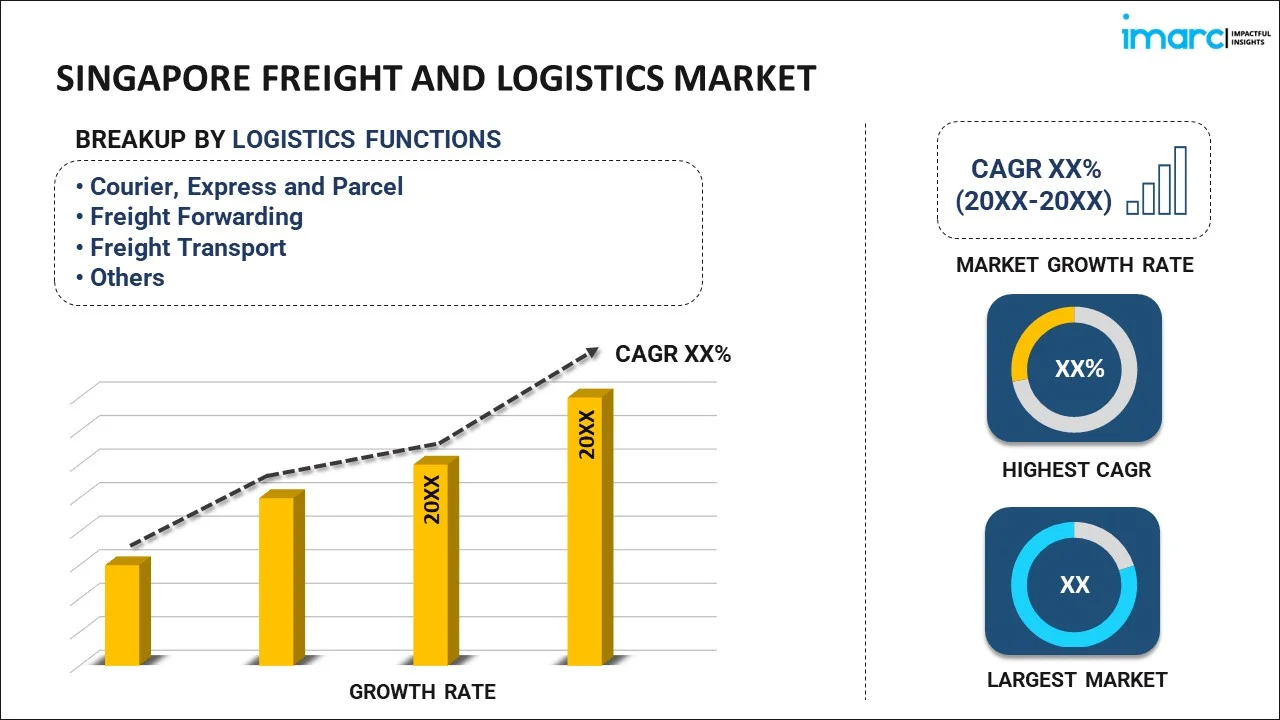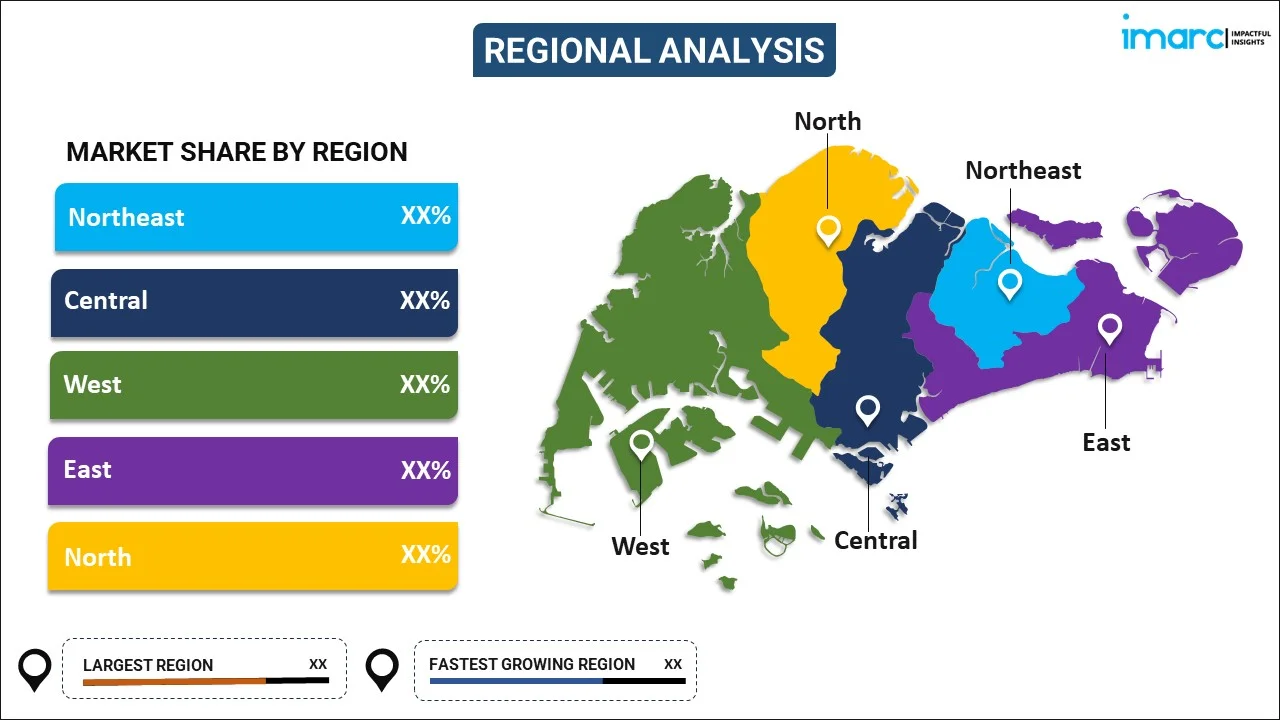
Singapore Freight and Logistics Market Report by Logistics Function (Courier, Express and Parcel, Freight Forwarding, Freight Transport, Warehousing and Storage, and Others), End Use Industry (Agriculture, Fishing and Forestry, Construction, Manufacturing, Oil and Gas, Mining and Quarrying, Wholesale and Retail Trade, and Others), and Region 2025-2033
Singapore Freight and Logistics Market Overview:
The Singapore freight and logistics market size reached USD 70.8 Billion in 2024. Looking forward, IMARC Group expects the market to reach USD 118.1 Billion by 2033, exhibiting a growth rate (CAGR) of 5.90% during 2025-2033. Key factors driving market growth include the expansion of e-commerce, Singapore's strategic geographic location, and its advanced infrastructure, which together ensure efficient global trade and continuous growth in supply chain services.
|
Report Attribute
|
Key Statistics
|
|---|---|
|
Base Year
|
2024 |
|
Forecast Years
|
2025-2033 |
|
Historical Years
|
2019-2024
|
| Market Size in 2024 | USD 70.8 Billion |
| Market Forecast in 2033 | USD 118.1 Billion |
| Market Growth Rate (2025-2033) | 5.90% |
Singapore Freight and Logistics Market Trends:
Growth of E-commerce and Retail Industries
A primary driver of growth in the Singapore freight and logistics market is the booming internet retail and overall retail sales, which have consistently increased in recent years. Singapore was one of many Southeast Asian nations with solid development in retail e-commerce in 2021. They had 12.5% growth and have a tech-savvy populace, which indicates well for advertisers and publishers trying to enter the market. The growth of online product sales necessitates enhancing supply chain management and logistics to meet customer needs effectively. The rapid expansion of e-commerce activities requires robust logistics support to ensure timely and adequate solutions for customers. Additionally, the entry of international brand networks into Singapore boosts the demand for efficient freight services for importing goods, warehousing, and distribution. As consumers increasingly shift their purchasing online, the pressure on the logistics segment intensifies, driving market growth.
Optimal Geographic Location and Superior Infrastructure
Singapore being a well-connected country with state-of-the-art facilities contribute significantly to its freight and logistics market growth. Located on the busiest freight-marine shipping network and airline routes, Singapore has become the influential player in the shipment of goods both by sea and air. In addition, the country boasts of world class port and other infrastructure, such as efficient airports, as well as well-developed roads that enable easy transportation. Government-supported initiatives to improve logistics, such as the development of new terminals and the integration of smart logistics solutions, enhance the industry's capacity to manage increased freight flow. Proactive government policies and initiatives, like the Singapore Green Plan 2030, foster a supportive environment for the sector. This competitive edge, combined with other factors such as significant improvements in the country's infrastructure, solidifies Singapore's status as a crucial logistics hub. These enhancements ensure the country's ability to support continuous market growth and progression. The strategic investments in infrastructure and logistics capabilities not only attract global businesses but also foster an environment conducive to innovation and efficiency, reinforcing Singapore's essential role in the global supply chain. This comprehensive approach ensures sustained development and strengthens Singapore's position as a leading logistics location.
Singapore Freight and Logistics Market News:
- In October 2023, DHL Supply Chain, the global market leader for contract logistics solutions, announced an investment of EUR350 million in Southeast Asia over the next five years to expand its warehousing capacity, workforce, and sustainability initiatives.
Singapore Freight and Logistics Market Segmentation:
IMARC Group provides an analysis of the key trends in each segment of the market, along with forecasts at the country level for 2025-2033. Our report has categorized the market based on logistics function and end use industry.
Logistics Function Insights:

- Courier, Express and Parcel
- By Destination Type
- Domestic
- International
- By Destination Type
- Freight Forwarding
- By Mode of Transport
- Air
- Sea and Inland Waterways
- Others
- By Mode of Transport
- Freight Transport
- By Mode of Transport
- Air
- Pipelines
- Rail
- Road
- Sea and Inland Waterways
- By Mode of Transport
- Warehousing and Storage
- By Temperature Control
- Non-Temperature Controlled
- Temperature Controlled
- By Temperature Control
- Others
The report has provided a detailed breakup and analysis of the market based on the logistics function. This includes courier, express and parcel [by destination type (domestic and international)], freight forwarding [by mode of transport (air, sea and inland waterways, and others)], freight transport [by mode of transport (air, pipelines, rail, road, and sea and inland waterways)], warehousing and storage [by temperature control (non-temperature controlled and temperature controlled)], and others.
End Use Industry Insights:
- Agriculture, Fishing and Forestry
- Construction
- Manufacturing
- Oil and Gas, Mining and Quarrying
- Wholesale and Retail Trade
- Others
A detailed breakup and analysis of the market based on the end use industry have also been provided in the report. This includes agriculture, fishing and forestry, construction, manufacturing, oil and gas, mining and quarrying, wholesale and retail trade, and others.
Regional Insights:

- North-East
- Central
- West
- East
- North
The report has also provided a comprehensive analysis of all the major regional markets, which include North-East, Central, West, East, and North.
Competitive Landscape:
The market research report has also provided a comprehensive analysis of the competitive landscape in the market. Competitive analysis such as market structure, key player positioning, top winning strategies, competitive dashboard, and company evaluation quadrant has been covered in the report. Also, detailed profiles of all major companies have been provided.
Singapore Freight and Logistics Market Report Coverage:
| Report Features | Details |
|---|---|
| Base Year of the Analysis | 2024 |
| Historical Period | 2019-2024 |
| Forecast Period | 2025-2033 |
| Units | Billion USD |
| Scope of the Report | Exploration of Historical Trends and Market Outlook, Industry Catalysts and Challenges, Segment-Wise Historical and Future Market Assessment:
|
| Logistics Functions Covered |
|
| End Use Industries Covered | Agriculture, Fishing and Forestry, Construction, Manufacturing, Oil and Gas, Mining and Quarrying, Wholesale and Retail Trade, Others |
| Regions Covered | North-East, Central, West, East, North |
| Customization Scope | 10% Free Customization |
| Post-Sale Analyst Support | 10-12 Weeks |
| Delivery Format | PDF and Excel through Email (We can also provide the editable version of the report in PPT/Word format on special request) |
Key Questions Answered in This Report:
- How has the Singapore freight and logistics market performed so far and how will it perform in the coming years?
- What has been the impact of COVID-19 on the Singapore freight and logistics market?
- What is the breakup of the Singapore freight and logistics market on the basis of logistics function?
- What is the breakup of the Singapore freight and logistics market on the basis of end use industry?
- What are the various stages in the value chai of the Singapore freight and logistics market?
- What are the key driving factors and challenges in the Singapore freight and logistics?
- What is the structure of the Singapore freight and logistics market and who are the key players?
- What is the degree of competition in the Singapore freight and logistics market?
Key Benefits for Stakeholders:
- IMARC’s industry report offers a comprehensive quantitative analysis of various market segments, historical and current market trends, market forecasts, and dynamics of the Singapore freight and logistics market from 2019-2033.
- The research report provides the latest information on the market drivers, challenges, and opportunities in the Singapore freight and logistics market.
- Porter's five forces analysis assist stakeholders in assessing the impact of new entrants, competitive rivalry, supplier power, buyer power, and the threat of substitution. It helps stakeholders to analyze the level of competition within the Singapore freight and logistics industry and its attractiveness.
- Competitive landscape allows stakeholders to understand their competitive environment and provides an insight into the current positions of key players in the market.
Need more help?
- Speak to our experienced analysts for insights on the current market scenarios.
- Include additional segments and countries to customize the report as per your requirement.
- Gain an unparalleled competitive advantage in your domain by understanding how to utilize the report and positively impacting your operations and revenue.
- For further assistance, please connect with our analysts.
 Inquire Before Buying
Inquire Before Buying
 Speak to an Analyst
Speak to an Analyst
 Request Brochure
Request Brochure
 Request Customization
Request Customization




.webp)




.webp)












